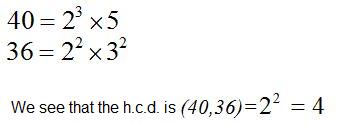SOLUTIONS FOR EXERCISES OF POINTS STUDIED SO FAR
3.61 If we have the number 15037, with what numbers do you have to change the zero (0) and the 7 in order for the whole number to be divisible by 3 and 4 (divisible by 12) at the same time?
Answer: We have to change the 7 for a 6 and the 0 for a 3.
Solution:
For a number to be divisible by 4, it must end in two zeros or the last two digits must be divisible by 4. 37 is not divisible by 4 but 36 is and it's close enough. We simply change 7 by 6.
We have left: 15036: I see that the sum of its digits is a multiple of 3:
1 + 5 + 0 + 3 + 6 = 15
Thus, this number is divisible by 3 and 4.
We can change the zero by 3, 6 or 9 so the sum of its digits remain a multiple of 3.
We can have three answers: 15336
15636
15936
Since all these numbers end in 36, they will be a multiple of 4 as well.
3.62 We have three iron bars of 360, 480 and 540 metres each. We have divided each bar into equal pieces in length (the highest possible length). How many pieces have we made and what is their length?
Answer:
Solution:
We have to calculate the highest number which when placed in the denominator position divides each iron bar an exact number of times. This means, we have to calculate the h.c.d. for (360, 480 and 540):
h.c.d. (360, 480 y 540) = 60
The total amount in metres for the 3 iron bars is: 360 + 480 + 540 = =1380

Answer: Each piece will be 60 metres long and there will be a total of 23 pieces.
3.63 When we divide 38 and 43 by a certain number, we get 2 and 3 as a remainder. Which number is the highest common denominator that leaves 2 and 3 as remainders?
Answer: 4
Solution:
If we divide 12 by 5, we will find that it is not an exact division. We get a remainder, in this case, of 2.
If we subtract the remainder (2) from the dividend (12), the quotient is exact. If you subtract 2 from 12, you will get 10. 10 is divisible by 5.
Let's go back to the exercise:
If we subtract 2 from 38: 38 – 2 = 36. If we divide 36 by this unknown number, we will get an exact division. Thus, 36 is a multiple of this denominator.
If we subtract 3 from 43: 43 – 3 = 40. If we divide 40 by this unknown denominator, we will get an exact division.
Now, we have to calculate the highest common denominator for 40 and 36:

3.64 We have three iron bars measuring 40, 60 and 80 metres respectively. We have divided each bar into equal pieces in length (the highest possible length). How many pieces have we made and what is their length?
Answer: Each piece is 20 metres long and we have a total of 9 pieces.
Solution:
We have to find the highest possible number, which when used as a denominator for 40, 60 and 80 gives us a remainder of zero.
We calculate the highest common denominator for the three numbers:

The highest common denominator for 40, 60 and 80 is 20.
Each piece is 20 metres long. To know the number of pieces we ca get, we calculate the total amount of metres for the three iron bars: 40 + 60 + 80 = 180 metres.
If each piece is 20 metres long, the number of pieces will be:


